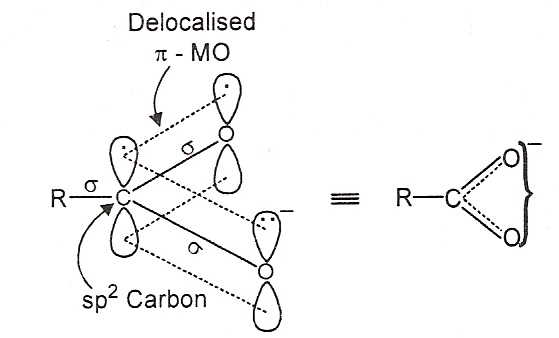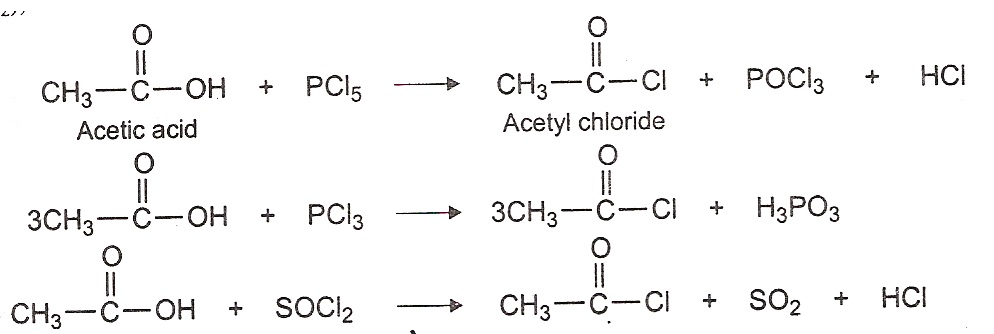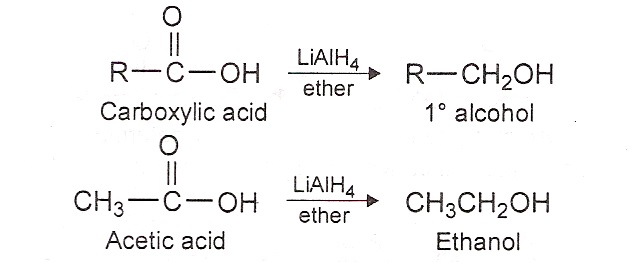Carboxylic Acid: Organic compounds which contain the carboxyl functional group (-COOH) are called the Carboxylic acids. Their general formula is:![]() Where R is alkyl group.
Where R is alkyl group.
The name carboxyl is derived from carbonyl (>C=O) and hydroxyl (-OH) because in the carboxyl group these two groups are directly bonded to each other. The properties of the carboxyl group are not simply those of carbonyl and hydroxyl groups combined; the two groups interact to give carboxylic acids their own distinctive properties.
Preparation: Carboxylic acids may be prepared by the following methods.
1) Oxidation of primary alcohols or aldehydes: Carboxylic acid is prepared by oxidation of primary alcohols or aldehydes in presence of acidified solution of potassium dichromate. The alcohol is first oxidized to an aldehyde, and then to carboxylic acid.

2) Hydrolysis of esters: When an ester is boiled with conc. solution of NaOH, sodium salt of the acid is formed which on treatment with dilute HCl gives carboxylic acid. e.g.

3) From Grignard reagent: Grignard reagents (RMgX) react with carbon dioxide to form addition products that can be hydrolysed to carboxylic acids.

4) Carboxylation of alkene: When an alkene is heated with CO and steam under pressure in presence of phosphoric acid at 400ºC, carboxylic are formed (Koch reaction).
 Physical properties: Lower carboxylic acids (upto C10) are liquids with sharp odours. Higher members are wax-like solids and almost odourless. Boiling points of carboxylic acids increase with increase in molecular mass. Boiling points of carboxylic acids are higher than those of alcohols of same molecular mass e.g.
Physical properties: Lower carboxylic acids (upto C10) are liquids with sharp odours. Higher members are wax-like solids and almost odourless. Boiling points of carboxylic acids increase with increase in molecular mass. Boiling points of carboxylic acids are higher than those of alcohols of same molecular mass e.g.
Acetic acid (CH3COOH) 60 (molecular wt.) 118ºc (bp).
1-Propanol (CH3CH2CH2OH) do 97ºc (bp).
This is attributed to hydrogen-bonding between acid molecules.
 Acidity of carboxylic acids: Carboxylic in acidic in nature because the carboxylate ion formed by ionization or reaction with a base is stabilized by resonance.
Acidity of carboxylic acids: Carboxylic in acidic in nature because the carboxylate ion formed by ionization or reaction with a base is stabilized by resonance.

The stability of carboxylate ion can also be explained on the basis of its molecular orbital structure. The carbon atom of carboxylate ion is sp2-hybridised. It is bound to each oxygen atom by σ-bond. The unused carbon p-orbital overlaps with p-orbitals of both oxygen atoms to form stable delocalized molecular orbital as shown below.

The delocalization of π-electrons is responsible for the extra-stability of the carboxylate ion.
Effect of Substituents on Acidity: The most important factor affecting the acidity is the inductive effect of substituents on the α-carbon atoms.
1) Electron releasing alkyl groups decrease the acidity because the electron releasing groups increase the negative charge on the carboxylate ion and delocalized it. The lose of proton becomes more difficult. Also, as the size of the alkyl group increases, acidity decreases. For examples,
HCOOH> CH3COOH> CH3CH2COOH
2) Electron-withdrawing substituents (Cl, Br, F, OH, and CN) increase the acidity as the electron withdrawing groups decrease the negative charge on the carboxylate ion and stabilized it. The lose of proton is relatively easy. For example, chloroaceitic acid is about 100 times stronger than acetic acid.
Cl—CH2—COOH > CH3—COOH
The strength of the electron withdrawing substituents determines the magnitude of the effect on acidity. For example, fluoroacetic acid is stronger than the chloroacetic acid since F is more electronegative than Cl.
F—CH2—COOH> Cl—CH2—COOH
As number of electron-withdrawing substituents increases, acidity also increases. For example,
Cl3—C—COOH > Cl2—CH—COOH > Cl—CH2—COOH
Chemical reaction of carboxylic acid: The reactions of carboxylic acids are as follows-
1) Salt formation: Carboxylic acids react with hydroxides, carbonates and bicarbonates to form the corresponding salts. For examples,
CH3—COOH + NaOH ——-> CH3—COONa + H2O
Acetic acid sodium acetate
CH3—COOH + Na2CO3 ——-> CH3—COONa + CO2 + H2O
Acetic acid sodium acetate
CH3—COOH + NaHCO3 ——-> CH3—COONa + CO2 + H2O
Acetic acid sodium acetate
2) Formation of acid halides: Carboxylic acid reacts with phosphorus halides or thionyl chloride (SOCl2), to form acid halides. For example, 3) Formation of amides: Carboxylic acids react with ammonia give salts, which on heating yield amides.
3) Formation of amides: Carboxylic acids react with ammonia give salts, which on heating yield amides.
 4) Formation of esters: Carboxylic acid reacts with alcohols in presence of a strong acid catalyst like H2SO4 or HCl to form esters. The reaction is reversible and is called esterification.
4) Formation of esters: Carboxylic acid reacts with alcohols in presence of a strong acid catalyst like H2SO4 or HCl to form esters. The reaction is reversible and is called esterification.
 5) Formation of anhydrides: Carboxylic undergo dehydration with phosphorus pentaoxide (P2O5) to form acid anhydrides.
5) Formation of anhydrides: Carboxylic undergo dehydration with phosphorus pentaoxide (P2O5) to form acid anhydrides.

Anhydrides can also be prepared by treating sodium salts of acids with acid halides.

6) Reduction: Carboxylic acid undergoes reduction with lithium aluminium hydride to give primary alcohols.
